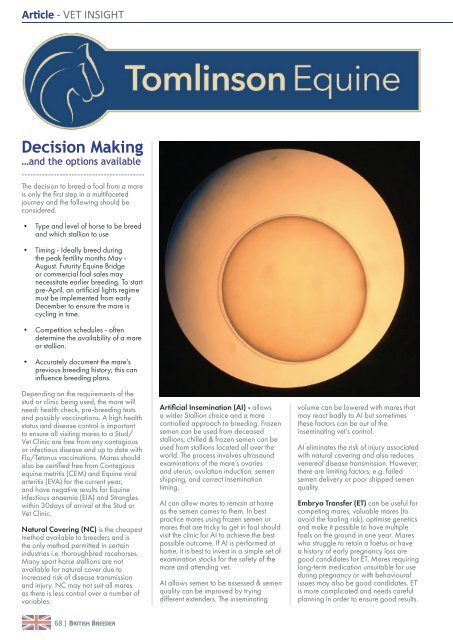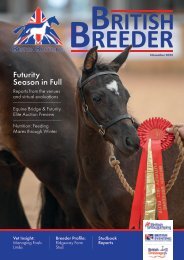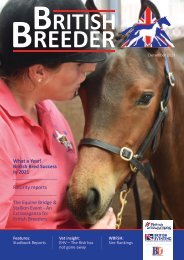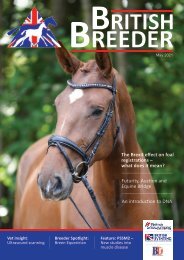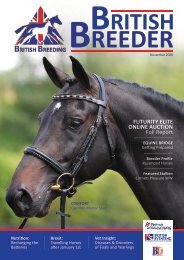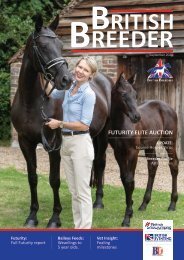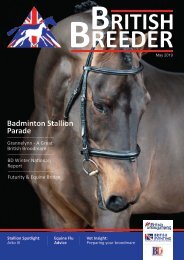British Breeder Magazine May 2020
Magazine for breeders of British bred sport horses. Includes breeding industry news, updates, interviews, profiles and reports.
Magazine for breeders of British bred sport horses. Includes breeding industry news, updates, interviews, profiles and reports.
You also want an ePaper? Increase the reach of your titles
YUMPU automatically turns print PDFs into web optimized ePapers that Google loves.
Article - VET INSIGHT<br />
Decision Making<br />
…and the options available<br />
The decision to breed a foal from a mare<br />
is only the first step in a multifaceted<br />
journey and the following should be<br />
considered.<br />
• Type and level of horse to be breed<br />
and which stallion to use<br />
• Timing - Ideally breed during<br />
the peak fertility months <strong>May</strong> -<br />
August. Futurity Equine Bridge<br />
or commercial foal sales may<br />
necessitate earlier breeding. To start<br />
pre-April, an artificial lights regime<br />
must be implemented from early<br />
December to ensure the mare is<br />
cycling in time.<br />
• Competition schedules - often<br />
determine the availability of a mare<br />
or stallion.<br />
• Accurately document the mare’s<br />
previous breeding history; this can<br />
influence breeding plans.<br />
Depending on the requirements of the<br />
stud or clinic being used, the mare will<br />
need: health check, pre-breeding tests<br />
and possibly vaccinations. A high health<br />
status and disease control is important<br />
to ensure all visiting mares to a Stud/<br />
Vet Clinic are free from any contagious<br />
or infectious disease and up to date with<br />
Flu/Tetanus vaccinations. Mares should<br />
also be certified free from Contagious<br />
equine metritis (CEM) and Equine viral<br />
arteritis (EVA) for the current year,<br />
and have negative results for Equine<br />
infectious anaemia (EIA) and Strangles<br />
within 30days of arrival at the Stud or<br />
Vet Clinic.<br />
Natural Covering (NC) is the cheapest<br />
method available to breeders and is<br />
the only method permitted in certain<br />
industries i.e. thoroughbred racehorses.<br />
Many sport horse stallions are not<br />
available for natural cover due to<br />
increased risk of disease transmission<br />
and injury. NC may not suit all mares<br />
as there is less control over a number of<br />
variables.<br />
Artificial Insemination (AI) - allows<br />
a wider Stallion choice and a more<br />
controlled approach to breeding. Frozen<br />
semen can be used from deceased<br />
stallions; chilled & frozen semen can be<br />
used from stallions located all over the<br />
world. The process involves ultrasound<br />
examinations of the mare’s ovaries<br />
and uterus, ovulation induction, semen<br />
shipping, and correct insemination<br />
timing.<br />
AI can allow mares to remain at home<br />
as the semen comes to them. In best<br />
practice mares using frozen semen or<br />
mares that are tricky to get in foal should<br />
visit the clinic for AI to achieve the best<br />
possible outcome. If AI is performed at<br />
home, it is best to invest in a simple set of<br />
examination stocks for the safety of the<br />
mare and attending vet.<br />
AI allows semen to be assessed & semen<br />
quality can be improved by trying<br />
different extenders. The inseminating<br />
volume can be lowered with mares that<br />
may react badly to AI but sometimes<br />
these factors can be out of the<br />
inseminating vet’s control.<br />
AI eliminates the risk of injury associated<br />
with natural covering and also reduces<br />
venereal disease transmission. However,<br />
there are limiting factors, e.g. failed<br />
semen delivery or poor shipped semen<br />
quality.<br />
Embryo Transfer (ET) can be useful for<br />
competing mares, valuable mares (to<br />
avoid the foaling risk), optimise genetics<br />
and make it possible to have multiple<br />
foals on the ground in one year. Mares<br />
who struggle to retain a foetus or have<br />
a history of early pregnancy loss are<br />
good candidates for ET. Mares requiring<br />
long-term medication unsuitable for use<br />
during pregnancy or with behavioural<br />
issues may also be good candidates. ET<br />
is more complicated and needs careful<br />
planning in order to ensure good results.<br />
68 | BRITISH BREEDER


